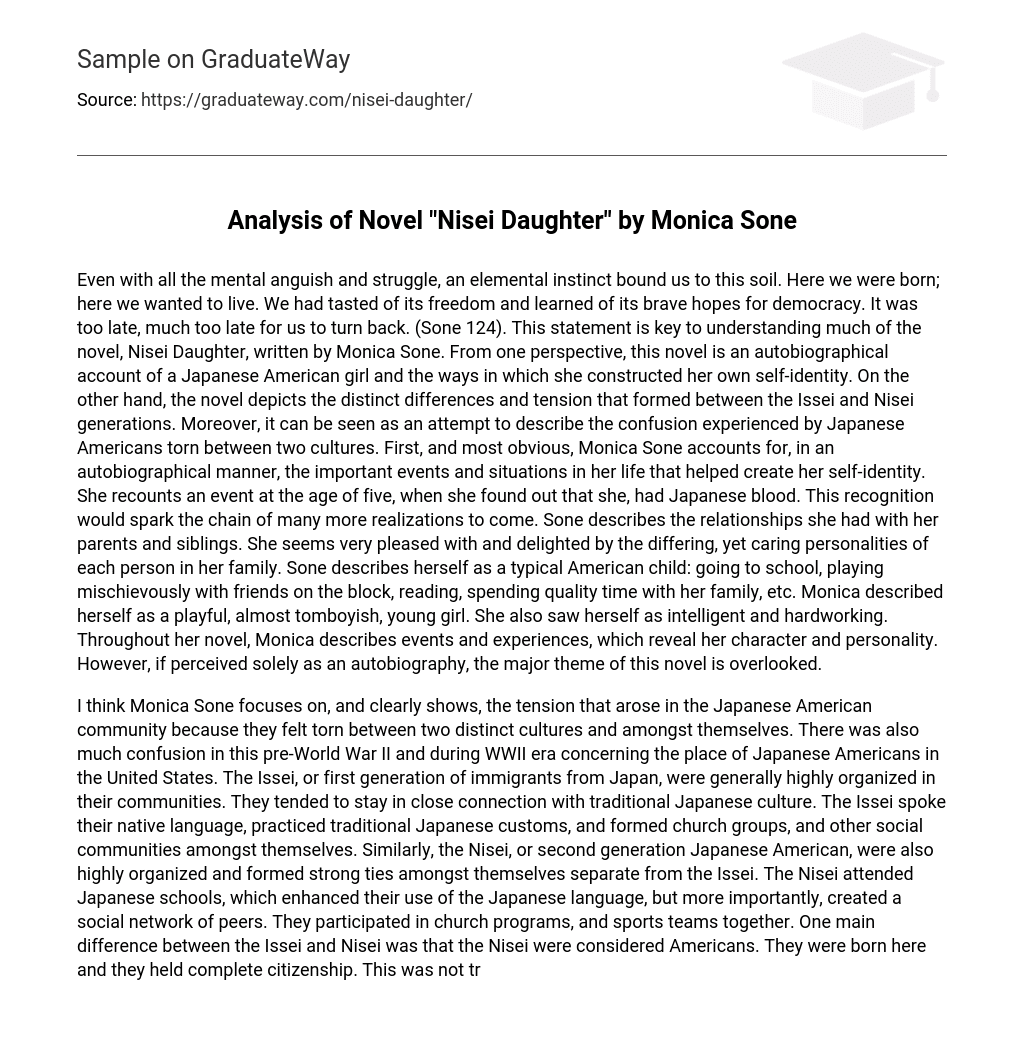Even with all the mental anguish and struggle, an elemental instinct bound us to this soil. Here we were born; here we wanted to live. We had tasted of its freedom and learned of its brave hopes for democracy.
It was too late, much too late for us to turn back. (Sone 124). This statement is key to understanding much of the novel, Nisei Daughter, written by Monica Sone. From one perspective, this novel is an autobiographical account of a Japanese American girl and the ways in which she constructed her own self-identity. On the other hand, the novel depicts the distinct differences and tension that formed between the Issei and Nisei generations. Moreover, it can be seen as an attempt to describe the confusion experienced by Japanese Americans torn between two cultures.
First, and most obvious, Monica Sone accounts for, in an autobiographical manner, the important events and situations in her life that helped create her self-identity. She recounts an event at the age of five, when she found out that she, had Japanese blood. This recognition would spark the chain of many more realizations to come. Sone describes the relationships she had with her parents and siblings. She seems very pleased with and delighted by the differing, yet caring personalities of each person in her family.
Sone describes herself as a typical American child: going to school, playing mischievously with friends on the block, reading, spending quality time with her family, etc. Monica described herself as a playful, almost tomboyish, young girl. She also saw herself as intelligent and hardworking. Throughout her novel, Monica describes events and experiences, which reveal her character and personality. However, if perceived solely as an autobiography, the major theme of this novel is overlooked. I think Monica Sone focuses on, and clearly shows, the tension that arose in the Japanese American community because they felt torn between two distinct cultures and amongst themselves.
There was also much confusion in this pre-World War II and during WWII era concerning the place of Japanese Americans in the United States. The Issei, or first generation of immigrants from Japan, were generally highly organized in their communities. They tended to stay in close connection with traditional Japanese culture. The Issei spoke their native language, practiced traditional Japanese customs, and formed church groups, and other social communities amongst themselves. Similarly, the Nisei, or second generation Japanese American, were also highly organized and formed strong ties amongst themselves separate from the Issei. The Nisei attended Japanese schools, which enhanced their use of the Japanese language, but more importantly, created a social network of peers.
They participated in church programs, and sports teams together. One main difference between the Issei and Nisei was that the Nisei were considered Americans. They were born here and they held complete citizenship. This was not true for the Issei. Another factor that separated the two generations was that Nisei, for the most part, were in daily contact with white Americans.
This contact came about through attending American schools and socializing with the mainstream Americans. The Issei were confused by the disloyalty of the Nisei to Japanese ways. In one situation told by Monica Sone, the Nisei took part in protests against Japanese freighters. The Nisei college students picketed with sandwich signs and saying, Halt the oil and stop the Japs!.
The Issei wondered amongst themselves, Dont they realize they, too, have Japanese blood coursing through their veins? (Sone 120). On the brink of WWII, however, the idea of Nisei citizenship came into question. The prejudice of mainstream Americans became quite clear. For example, when the Itois (Sones family) attempted to find a place to live on the beach because her younger sister was ill, they were completely rebuffed. Mr. Kato was quoted, Theyve never rented or sold houses to Orientals and I doubt if they ever will.
(Sone 115). Monica Sone was extremely confused, hurt, and ashamed, all at the same time because her ancestry suddenly became her identity. Being encamped during the war furthered this confusion and resentment. She had always considered herself an American, but, as she states, I no longer had the right to walk out of it. It was because I had Japanese ancestors.
(Sone 177). Although Sone, along with many others, was presented with an extreme identity crisis, she stayed strong and determined to live a satisfying life in America. I have much respect for her because of this. She left the camp in Idaho as soon as she was allowed and moved eastward, to Chicago. She lived with the Richardsons, a loving and hospitable family. They helped her enroll in a college in Indiana.
In conclusion, Monica Sone was fortunate enough to attend college and see a different part of America. Her feelings of being split between two cultures dissipated with knowledge and exposure to open-minded Americans. As Sone states conclusively, The Japanese and the American parts of me were now blended into one. (Sone 238).





